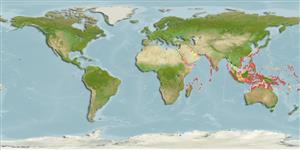Preferred temperature (Ref.
123201): 13.4 - 27.1, mean 22.3 °C (based on 605 cells).
Phylogenetic diversity index (Ref.
82804): PD
50 = 0.5005 [Uniqueness, from 0.5 = low to 2.0 = high].
Bayesian length-weight: a=0.01514 (0.00669 - 0.03426), b=3.01 (2.81 - 3.21), in cm total length, based on LWR estimates for this (Sub)family-body shape (Ref.
93245).
Trofisk nivå (Ref.
69278): 3.4 ±0.45 se; based on food items.
Resiliens (Ref.
120179): Hög, lägsta populationsfördubblingstid mindre än 15 månader (Preliminary K or Fecundity.).
Fishing Vulnerability (Ref.
59153): Low vulnerability (10 of 100).
🛈
Nutrients (Ref.
124155): Calcium = 129 [64, 208] mg/100g; Iron = 0.939 [0.537, 1.576] mg/100g; Protein = 18.3 [17.1, 19.5] %; Omega3 = 0.126 [0.071, 0.214] g/100g; Selenium = 24.6 [12.3, 49.4] μg/100g; VitaminA = 127 [38, 419] μg/100g; Zinc = 1.5 [1.0, 2.2] mg/100g (wet weight);
